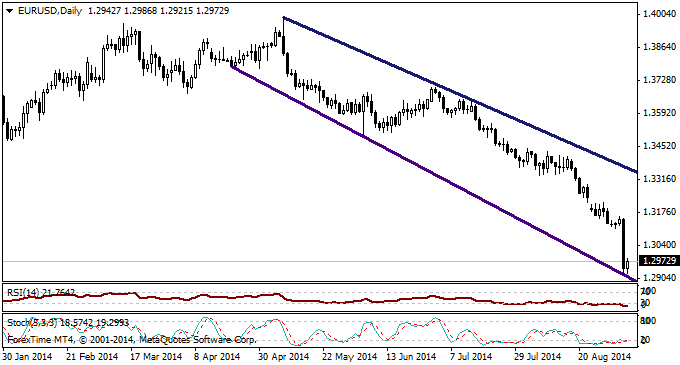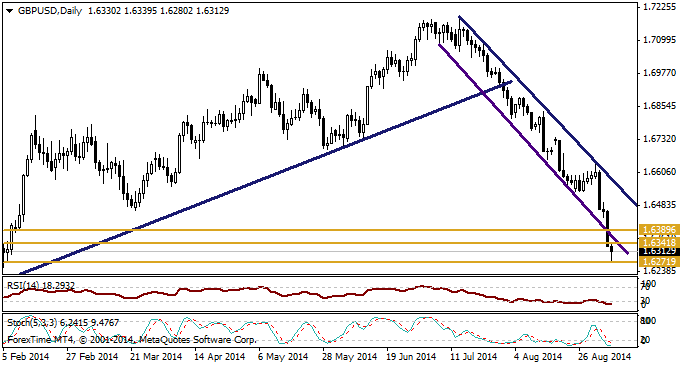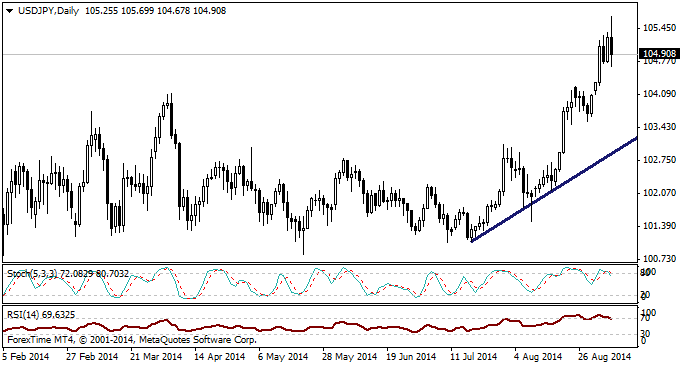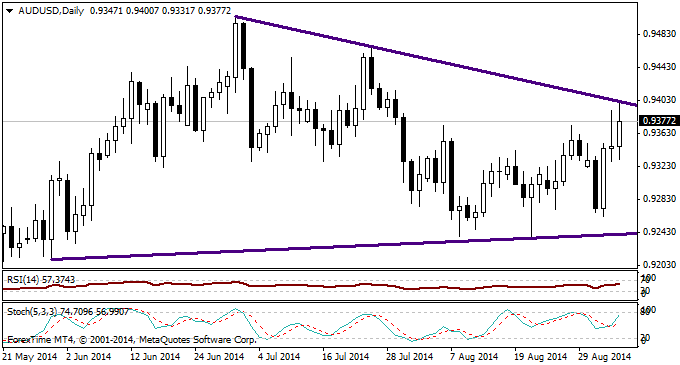The European Central Bank (ECB) shocked the financial markets on Thursday afternoon by unexpectedly acting again in its ongoing battle against low inflation levels. Not only did the ECB cut interest rates to a new record low 0.05% but the central bank also raised negative deposit rates to 0.2%. Furthermore, the ECB announced plans to launch an asset purchase program. This unexpected news sent the EURUSD to its lowest value in over a year (1.2919).
The equally surprising news that the United States only created 142,000 new jobs in August gave the sudden downward movement in the EURUSD some breathing space, with the 1.2919 area now emerging as the next featured support level for the pair.
In other news, there was optimism following suggestions from German economic releases that the EU’s main GDP contributor was returning to form. German Industrial Production recorded its strongest month in over two years during July, with a 1.9% increase. This was subsequently followed by the impressive news that Factory Orders rose by 4.6% in the same month.
This week, economic data from the European Union is lower in quantity. The most noticeable releases include German Trade Balance (Tuesday) German CPI (Wednesday) and the latest EU unemployment statistics (Friday). It is also being suggested that further Russian economic sanctions will be announced at the beginning of the week, which should weigh on the EURUSD.
In regards to the technicals on the Daily timeframe, a bearish channel remains in control of the overall EURUSD direction. However, we are now moving further towards the lower end of the channel and if the pair is going to following technical patterns, a consolidation of losses is possible. This would be helped if there are further signs that German data is returning to stability. Equally, the surprisingly poor US NFP could encourage concerns that the Federal Reserve will delay monetary tightening.
Support levels can be found at 1.2940, alongside the current yearly low, 1.2919. If the EURUSD is going to return to the 1.30 area, resistance can be found at 1.3013 and 1.3051.
Downside GBPUSD movement accelerates
Despite impressively strong performances from the UK economy last week, downside movement in the GBPUSD accelerated with the pair declining by over 200 pips. The latest UK Construction PMI was recorded at its highest in seven months, with this being subsequently followed by Wednesday’s news that UK Services growth had reached a 10 month high. Further positive news included The Office for National Statistics (ONS) revising upwards the estimates for UK GDP growth, as well as a report showing that the UK had moved up the global rankings in an annual survey by the World Economic Forum (WEF).
Nonetheless, a YouGov poll indicating that Yes and No votes for a Scottish referendum had narrowed raised fears of political instability within the United Kingdom. This encouraged a sharp decline in the GBPUSD. Additionally, awareness from investors that regardless of impressive UK fundamental performances, the BoE were still unlikely to raise rates added to the downward momentum.
There is a high quantity of UK economic data released on Tuesday. This includes Trade Balance, Manufacturing and Industrial Production and the NIESR GDP estimate of August. Additionally, there are reports of plans for a speech from Governor Carney also taking place on the same day. In regards to the upcoming Scottish referendum, the prospect of an independent Scotland is clearly gaining momentum and causing unease among investors. An independent Scotland had not been priced into the markets before, but is certainly having an impact now.
From a technical standpoint on the Daily timeframe, the GBPUSD looks very bearish. The Cable is now teasing the conclusion of a downward channel which has controlled the pair’s direction since late June, with further moves south likely accelerating when the channel is confirmed as having ended. In which case, support can be found at 1.6271 and 1.6209.
USDJPY now teasing a pullback
This pair moved bullishly last week and even reached a 6-year high (105.699) as US economic indicators pointed towards further signs of an economic recovery. During August, the US Manufacturing sector expanded at its fastest rate since March 2011 during August. This was positively for 3Q GDP data and raised expectations for a strong US job report to conclude the week.
However, an unusually weak US jobs report on Friday raised a few eyebrows regarding how the Federal Reserve might react to a weak employment report and encouraged the USDJPY to pullback from the milestone 6 year high.
Before next Friday’s US Advance Retail Sales release, the week is dominated by more regular Japanese news. This includes the latest BoJ Meeting Minutes, Factory Orders and a speech by BoJ Governor Kuroda in the late hours of Thursday evening. The BoJ have expressed consistent confidence throughout 2014 that monetary goals remain achievable. A reiteration of this stance from the BoJ this week should help the JPY.
From a technical standpoint on a Daily timeframe, a bullish trendline is in control.
However, both the Stochastic Oscillator and RSI are now suggesting that a pullback is now forthcoming. From a fundamental perspective this is supported by the US employment report pausing the Greenback rally, as well as the BoJ likely maintaining confidence that monetary goals are achievable. Potential support levels can be found at 104.644 and 104.259.
Aussie makes a comeback
The Aussie commenced last week with the latest Reserve Bank of Australia (RBA) Monetary Policy Statement reporting than an overvalued currency was hindering the Australian economy transition away from mining investment. The Aussie subsequently concluding trading on last Monday evening at its lowest value in over a fortnight, 0.9272.
Aussie losses refused to be the theme of the week though, with investors reacting positively to the announcement that second quarter Australian GDP grew at an annualised 3.1%. Additionally, monthly Retail Sales increased by 0.4% and discarded fears that decade high unemployment would lead to a decline in consumer spending.
The latest Australian employment report on Thursday morning represents a major risk to the Aussie next week. The previous month’s abysmal employment report sent warning signs towards investors that perhaps Governor Stevens was right with his previous comments that investors were underestimating a significant drop in the Aussie. If Thursday’s employment report follows the previous month’s pattern, the AUDUSD valuation will be under pressure.
The technicals on the Daily timeframe are suggesting that the pair is being traded in an ascending triangle. The Stochastic Oscillator and RSI are now moving closely towards the overbought boundaries, with the current price also coming close to touching the upper trendline of the wedge. As long as the Aussie follows the technicals, buying pressure should cool down.
This would no doubt please an RBA who are continually reiterating that the Australian currency remains overvalued. Potential support can be found at 0.9343 and 0.9314.
Comparebroker is a comparison site and we spend hundreds of hours to keep the information up to date. However, users are advised to do their own due diligence and nothing can be perceived any advise. The content on the website is purely for education purposes only
Recommended Content
Editors’ Picks
EUR/USD edges lower toward 1.0700 post-US PCE

EUR/USD stays under modest bearish pressure but manages to hold above 1.0700 in the American session on Friday. The US Dollar (USD) gathers strength against its rivals after the stronger-than-forecast PCE inflation data, not allowing the pair to gain traction.
GBP/USD retreats to 1.2500 on renewed USD strength

GBP/USD lost its traction and turned negative on the day near 1.2500. Following the stronger-than-expected PCE inflation readings from the US, the USD stays resilient and makes it difficult for the pair to gather recovery momentum.
Gold struggles to hold above $2,350 following US inflation

Gold turned south and declined toward $2,340, erasing a large portion of its daily gains, as the USD benefited from PCE inflation data. The benchmark 10-year US yield, however, stays in negative territory and helps XAU/USD limit its losses.
Bitcoin Weekly Forecast: BTC’s next breakout could propel it to $80,000 Premium

Bitcoin’s recent price consolidation could be nearing its end as technical indicators and on-chain metrics suggest a potential upward breakout. However, this move would not be straightforward and could punish impatient investors.
Week ahead – Hawkish risk as Fed and NFP on tap, Eurozone data eyed too

Fed meets on Wednesday as US inflation stays elevated. Will Friday’s jobs report bring relief or more angst for the markets? Eurozone flash GDP and CPI numbers in focus for the Euro.



